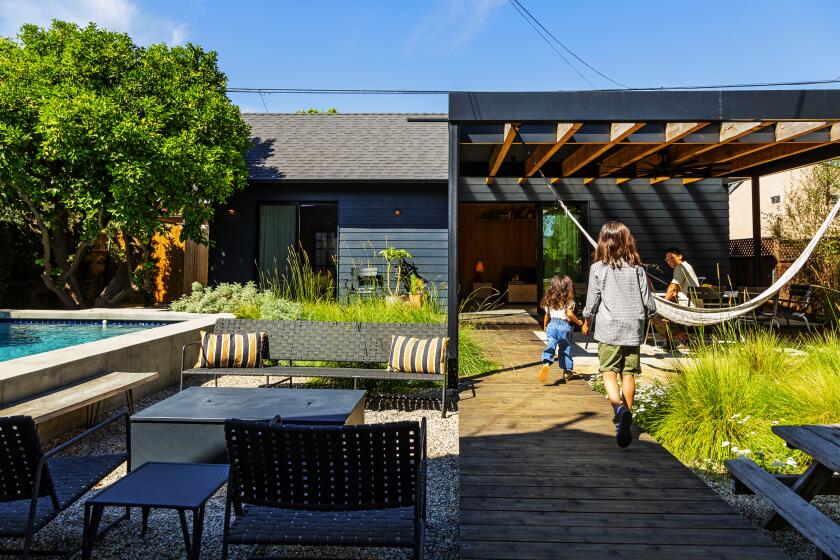One of Pasadena’s architectural jewels gets a polishing
- Share via
Pasadena City Hall can be characterized as a beaux-arts rendition of a Renaissance-style palace, topped like a wedding cake with a Spanish Baroque dome. And it’s back in the limelight after a $117-million renovation and seismic retrofit.
The landmark has appeared in movies and TV shows, portrayed as a mental institution, a police station and even the Supreme Court building. Now City Hall is receiving star billing around town as city officials reopen it in phases after three years of restoration.
Refurbished inside and out, including new plumbing, the 80-year-old edifice contains 235 rooms and passageways covering 170,000 square feet. Listed on the National Register of Historic Places, the building is surrounded by giant oak and magnolia trees and a Spanish Colonial courtyard that boasts a Baroque stone fountain.
It was first envisioned by civic leaders in 1922 during the City Beautiful movement as the “Athens of the West,” rising at the foot of the San Gabriel Mountains, the centerpiece of the Pasadena Civic Center. The next year, voters approved a $3.5-million bond issue to build the City Hall, a library and a civic auditorium, all linked by grand boulevards. The library was first to open, in February 1927.
San Francisco architects John R. Bakewell Jr. and Arthur Brown Jr., who had designed San Francisco’s lavish domed City Hall a decade earlier, won Pasadena’s architectural design contest. Influenced by the style of Andrea Palladio, a 16th century Italian architect who favored Renaissance classicism, the team designed a rectangular building with a six-story circular tower.
The dome is tiled in a fish-scale pattern and topped by a lantern, a 41-foot-high cupola resting on columns, paying homage to domes gracing edifices such as St. Paul’s Cathedral in London, the Hotel des Invalides in Paris, where Napoleon is entombed, and the church of Santa Maria della Salute in Venice.
Construction of the $1.34-million City Hall on Garfield Avenue began in January 1926 and required more than 1 million board feet of lumber, 20,000 cubic yards of concrete and more than 35,000 tons of rock and gravel from the San Gabriel River. Its interior speaks to custom craftsmanship, using materials such as Alaskan marble, cast stone, wrought iron, copper, vertical-grained white oak and Cordova clay tiles.
When it opened Dec. 27, 1927, it was considered to be among the strongest buildings in Southern California. It was also the tallest in Pasadena, its dome topping out at 206 feet.
“There’s an old joke that City Hall opened for business five days before the 1928 Rose Parade so they could put the entry fees into the shiny new cash registers,” said Ann Erdman, public information officer for the city.
Over the years, City Hall’s attractions have proved irresistible to moviemakers. Its courtyard stood in for a Napa Valley town square in the 1995 movie “A Walk in the Clouds,” starring Keanu Reeves and Anthony Quinn. Quinn rode through the rotunda on a white horse.
“The location managers searched that region for the perfect Napa-style courtyard for the big fiesta scene, and they finally found it -- at Pasadena City Hall,” Erdman said.
The imposing landmark also posed as an embassy in the “Mission: Impossible” television series, the Beverly Hills police station in all the “Beverly Hills Cop” movies -- despite the fact that the real Beverly Hills police station is itself glamorous -- and as a villa in Charlie Chaplin’s Oscar-nominated 1940 film “The Great Dictator.”
In a city where historic preservation is much like a civic obsession, City Hall has long been among the crown jewels of Pasadena, along with the Colorado Street Bridge, the Rose Bowl and the Gamble House. Although the renovation has been among the costliest public works projects in Pasadena, city officials decided that they couldn’t risk losing the landmark in another quake.
The work was funded by local tax revenue, the sale of bonds and an increase in the percentage of electricity revenue that is annually transferred from the city’s light and power fund to the general fund. It also received grants from the Federal Emergency Management Agency and the state, as well as contributions from individuals and foundations.
The entire civic center area has undergone a major face-lift in the last seven years, beginning with the demolition of an enclosed mall called Pasadena Plaza in 2000, which had become an eyesore. Residents will long remember how a bulldozer smashed through the mall as onlookers listened to the strains of classical music and the crowd cheered.
Now, City Hall, the Civic Auditorium and the library are back in an unobstructed “view corridor,” and the old mall has been transformed into the fashionable Paseo Colorado.
*






